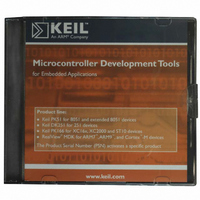MDK-ARM Keil, MDK-ARM Datasheet - Page 117

MDK-ARM
Manufacturer Part Number
MDK-ARM
Description
KIT REALVIEW MCU DEVELOPMENT
Manufacturer
Keil
Type
Compiler and IDEr
Specifications of MDK-ARM
For Use With/related Products
ARM MCUs
Lead Free Status / RoHS Status
Lead free / RoHS Compliant
- Current page: 117 of 156
- Download datasheet (3Mb)
Getting Started: Building Applications with RL-ARM
117
Device Configuration
When a device is first connected to the USB host, its signaling speed is
determined. It has Endpoint 0 configured to accept a Control pipe. In addition,
every new device that is plugged onto the network is assigned address 0. This
way the USB host knows which bit rate to use. It has one control channel
available at address 0 Endpoint 0. This Control pipe is then used by the host-PC
to determine the capabilities of the new device and to add it to the network. This
process is called “Enumeration”. Therefore, in addition to configuring the USB
peripheral within the microcontroller, you need to provide some firmware that
responds to the USB host enumeration requests. The data requested by the host
is held in a hierarchy of descriptors. The device descriptors are arrays of data,
which fully describe the USB device’s communication interface.
The descriptors are simply arrays of data, which must be transferred to the host in
response to enumeration requests. As you can see from the picture above, it is
possible to build complex device configurations. This is because the USB
network has been designed to be as flexible and as future-proof as possible.
However, the minimum number of descriptors required is a device descriptor,
configuration descriptor, interface descriptor, and three Endpoint descriptors (one
control, one IN and one OUT pipe).
Related parts for MDK-ARM
Image
Part Number
Description
Manufacturer
Datasheet
Request
R

Part Number:
Description:
KIT REALVIEW MCU DEVELOPMENT
Manufacturer:
Keil
Datasheet:

Part Number:
Description:
Development Software SUPPORT EXTENSION FOR MDK-ARM-B
Manufacturer:
Keil Software

Part Number:
Description:
Development Software SUPPORT EXTENSION FOR MDK-ARM
Manufacturer:
Keil Software

Part Number:
Description:
KIT REALVIEW MCU DEVELOPMENT
Manufacturer:
Keil
Datasheet:

Part Number:
Description:
Development Software MCU DEV KIT FOR ARM UPG TO FLOATING LIC
Manufacturer:
Keil Tools

Part Number:
Description:
Development Software MCU DEV KIT FOR ARM W/ FLOATING LICENSE
Manufacturer:
Keil Software

Part Number:
Description:
Development Software MCU DEV KIT FOR ARM uVISION & C++ & RTX
Manufacturer:
Keil Tools

Part Number:
Description:
Development Software SUPP LICENSE RENEWAL 90+ DAYS NO TECH SUP
Manufacturer:
Keil Software
Part Number:
Description:
KEIL C-COMPILER INTERNATIONAL
Manufacturer:
Silicon Laboratories Inc

Part Number:
Description:
BOARD EVAL FOR LPC213X ARM MCU
Manufacturer:
NXP Semiconductors
Datasheet:
Part Number:
Description:
K60N512 Keil Tower Kit
Manufacturer:
Freescale Semiconductor
Datasheet:










